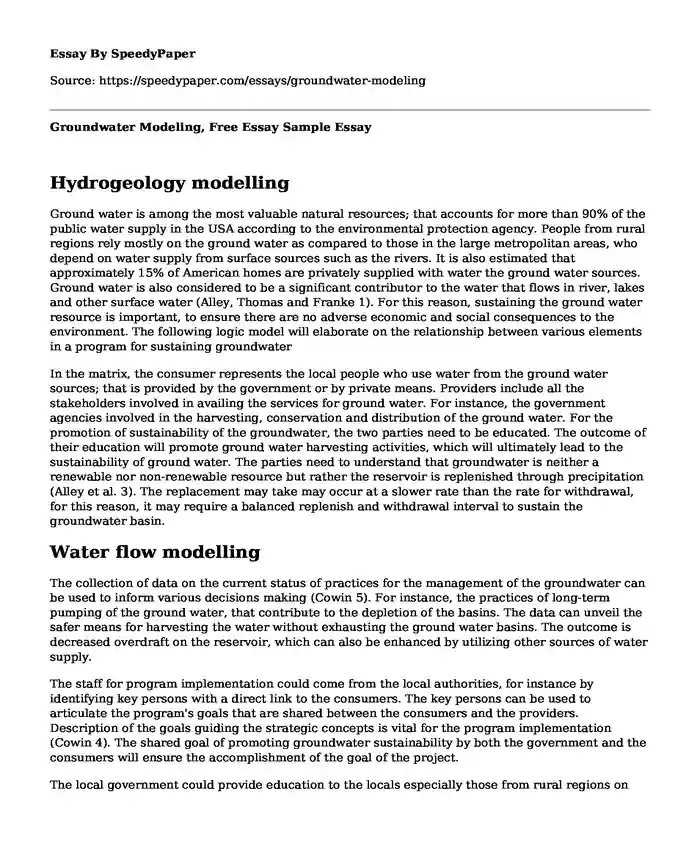Hydrogeology modelling
Ground water is among the most valuable natural resources; that accounts for more than 90% of the public water supply in the USA according to the environmental protection agency. People from rural regions rely mostly on the ground water as compared to those in the large metropolitan areas, who depend on water supply from surface sources such as the rivers. It is also estimated that approximately 15% of American homes are privately supplied with water the ground water sources. Ground water is also considered to be a significant contributor to the water that flows in river, lakes and other surface water (Alley, Thomas and Franke 1). For this reason, sustaining the ground water resource is important, to ensure there are no adverse economic and social consequences to the environment. The following logic model will elaborate on the relationship between various elements in a program for sustaining groundwater
In the matrix, the consumer represents the local people who use water from the ground water sources; that is provided by the government or by private means. Providers include all the stakeholders involved in availing the services for ground water. For instance, the government agencies involved in the harvesting, conservation and distribution of the ground water. For the promotion of sustainability of the groundwater, the two parties need to be educated. The outcome of their education will promote ground water harvesting activities, which will ultimately lead to the sustainability of ground water. The parties need to understand that groundwater is neither a renewable nor non-renewable resource but rather the reservoir is replenished through precipitation (Alley et al. 3). The replacement may take may occur at a slower rate than the rate for withdrawal, for this reason, it may require a balanced replenish and withdrawal interval to sustain the groundwater basin.
Water flow modelling
The collection of data on the current status of practices for the management of the groundwater can be used to inform various decisions making (Cowin 5). For instance, the practices of long-term pumping of the ground water, that contribute to the depletion of the basins. The data can unveil the safer means for harvesting the water without exhausting the ground water basins. The outcome is decreased overdraft on the reservoir, which can also be enhanced by utilizing other sources of water supply.
The staff for program implementation could come from the local authorities, for instance by identifying key persons with a direct link to the consumers. The key persons can be used to articulate the program's goals that are shared between the consumers and the providers. Description of the goals guiding the strategic concepts is vital for the program implementation (Cowin 4). The shared goal of promoting groundwater sustainability by both the government and the consumers will ensure the accomplishment of the goal of the project.
The local government could provide education to the locals especially those from rural regions on the land use and its impact on the ground water. For instance, the overuse of ground water for irrigation purposes and also the use of fertilizers that contribute to the contamination of ground water reservoirs. The understanding by consumers on the relationship between land use and the effect on groundwater is critical since it will allow the integration of the two entities. The locals can be advised in the process of program implementation, to embrace the activities that promote groundwater sustainability. For instance, they can adopt organic farming instead of applying the chemical fertilizers which pollutes the ground water sources.
Conclusion
Sustainability of ground water starts with gathering and analyzing quality data which has been acquired by following all of the data collection fidelities. The data can always reveal the gaps which can be addressed to promote sustainability. Collaboration between the provider and consumers is the ultimate solution for managing underground water. Providing adequate knowledge and skills for the consumers and providers in handling groundwater can lead to highest levels of sustainability. The balance between the withdrawal and replenishing of the ground water basins has a long-term effect on sustainability. Pumping mechanisms that allow not only the withdrawal of the ground water but also promoting some surface water to reach the ground pools contributes to the sustainability.
Work cited
Alley, William M., Thomas E. Reilly, and O. Lehn Franke. Sustainability of ground-water resources. Vol. 1186. US Department of the Interior, US Geological Survey, 1999.
Cowin, Mark. "California Department of Water Resources Sustainable ..." Water.ca.gov. California Department of Water Resources, 2015. Web. 17 Nov. 2016.
Cite this page
Groundwater Modeling, Free Essay Sample. (2017, Dec 27). Retrieved from https://speedypaper.net/essays/groundwater-modeling
Request Removal
If you are the original author of this essay and no longer wish to have it published on the SpeedyPaper website, please click below to request its removal:
- Free Essay: India in the Wake of Modern Education and Cultural Values
- Free Essay on Significance of Mandatory Military Service
- Essay Sample on Russian 19th Century Literature
- Free Essay: Quantitative Nursing Research Critique
- Essay Sample on Colonization and Resistance of Indio-America
- Free Essay about Cognitive-Behavioral Therapy Techniques
- American History Essay Example: The Great Migration
Popular categories





